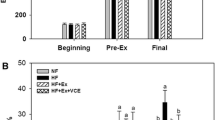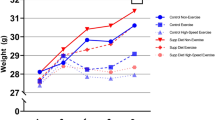Abstract
Nutritional supplementation with some amino acids may influence host’s responses and also certain mechanism involved in tumor progression. It is known that exercise influences body weight and muscle composition. Previous findings from our group have shown that leucine has beneficial effects on protein composition in cachectic rat model as the Walker 256 tumor. The main purpose of this study was to analyze the effects of light exercise and leucine and/or glutamine-rich diet in body composition and skeletal muscle protein synthesis and degradation in young tumor-bearing rats. Walker tumor-bearing rats were subjected to light aerobic exercise (swimming 30 min/day) and fed a leucine-rich (3%) and/or glutamine-rich (4%) diet for 10 days and compared to healthy young rats. The carcasses were analyzed as total water and fat body content and lean body mass. The gastrocnemious muscles were isolated and used for determination of total protein synthesis and degradation. The chemical body composition changed with tumor growth, increasing body water and reducing body fat content and total body nitrogen. After tumor growth, the muscle protein metabolism was impaired, showing that the muscle protein synthesis was also reduced and the protein degradation process was increased in the gastrocnemius muscle of exercised rats. Although short-term exercise (10 days) alone did not produce beneficial effects that would reduce tumor damage, host protein metabolism was improved when exercise was combined with a leucine-rich diet. Only total carcass nitrogen and protein were recovered by a glutamine-rich diet. Exercise, in combination with an amino acid-rich diet, in particular, leucine, had effects beyond reducing tumoral weight such as improving protein turnover and carcass nitrogen content in the tumor-bearing host.

Similar content being viewed by others
References
Albanese AA, Orto LA (1963) Protein and amino acids. In: Newer methods of nutritional biochemistry. Academic Press 1:1–112
Bacurau RFP, Belmonte MA, Seelaender MCL, Costa Rosa LFBP (2000) Effect of a moderate intensity exercise training protocol on the metabolism of macrophages and lymphocytes of tumour-bearing rats. Cell Biochem Funct 18:249–258
Bradford MM (1976) A rapid and sensitive method for quantification of microgram quantities of protein utilizing the principle of protein-dye-biding. Anal Biochem 72:248–254
Carroll PV, Jackson NC, Russell-Jones DL, Treacher DF, Sönksen PH, Umpleby AM (2004) Combined growth hormone/insulin–like growth factor I in addition to glutamine-supplemented TPN results in net protein anabolism in critical illness. Am J Physiol 286(1):E151–E157
Cohn SH, Ellis KJ, Vartsky D, Sawit-sky A, Gartenhaus W, Yasumura S, Vaswani AN (1981) Comparison of methods of estimating body fat in normal subjects and cancer patients. Am J Clin Nutr 34:2839–2847
Coombes JS, McNaughton LR (2000) Effects of branched-chain amino acid supplementation on serum creatine kinase and lactate dehydrogenase after prolonged exercise. J Sports Med Phys Fitness 40:240–246
Crevenna R, Schmidinger M, Keilani M, Nur H, Zoch C, Zielinski C, Fiakamoser V, Quittan M (2003) Aerobic exercise as additive palliative treatment for a patient with advanced hepatocellular cancer. Wien Med Wochenschr 153(9–10):237–240
Dejong CH, van de Poll MC, Soeters PB, Jalan R, Olde Damink SW (2007) Aromatic amino acid metabolism during liver failure. J Nutr 137(6 Suppl 1):1579S–1585S
Dimeo F, Rumberger BG, Keul J (1998) Aerobic exercise as therapy for cancer fatigue. Med Sci Sports Exerc 30(4):475–478
Drott C, Perssonh LK (1989) Cardiovascular and metabolic response to adrenaline-infusion in weight-losing patients with and without cancer. Clin Physiol 9(5):427–439
Falconer JS, Fearon KCH, Plester CE (1994) Cytokines the acute phase response and energy expenditure in cachetic patients with pancreatic cancer. Ann Surg 219:325–331
Farrell PA, Hernandez JM, Fedele MJ, Vary TC, Kimball SR, Jefferson LS (2000) Eukaryotic initiation factors and protein synthesis after resistance exercise in rats. J Appl Physiol 88:1036–1042
Fedele MJ, Thomas CV, Farrelll PA (2001) Selected contribution: IGF–I antibody prevents increases in protein syntesis in epitrochlearis muscles from reefed, diabetic rats. J Appl Physiol 90:1166–1173
Field CJ, Johnson I, Pratt VC (2000) Glutamine and arginine: immunonutrients for improved health. Med Sci Sports Exerc 32(7):S377–S388
Gad SC, Weil CS (1994) Statistic for toxicologists. In: Wallace H (ed) Principles and methods of toxicology. Raven, New York, pp 221–275
Glaspy J (2001) Anemia and fatigue in cancer patients. Cancer 92:1719–1724
Gobatto CA, Mello MA, Souza CT, Ribeiro IA (2002) The monosodium glutamate (MSG) obese rat as a model for the study of exercise in obesity. Res Commun Mol Pathol Pharmacol 111:89–101
Gomes Mercedes MCC, Parreira MR, Elias C, Áreas MA, Cury L (1990) Effects of Walker 256 carcinoma on metabolic alterations during the evolution of pregnancy. Braz J Med Biol Res 23:909–913
Gomes-Marcondes MCC, Cury L, Curi R (1998) Consequences of walker 256 tumor grown for the placental/fetal development in rats. Cancer Res Ther Control 5:277–283
Gomes-Marcondes MCC, Ventrucci G, Toledo MT, Cury L, Cooper JC (2003) A leucine-supplemented diet improved protein content of skeletal muscle in young tumor-bearing rats. Braz J Med Biol Res 36:1589–1594
Gonçalves EL, Waitzberg DL, Bevilacqua RG, Bevilacqua LR (1990) Body composition in various nutritional conditions. Experimental study. Rev Paul Med 108:125–133
Holecek MD (2002) Relation between glutamine; branched-chain amino acids and protein metabolism. Nutrition 18(2):130–133
Inui A (1999) Cancer anorexia–caquexia syndrome. Cancer Res 59:4493–4501
Lowry OH (1951) Protein measurement with the folin phenol reagent. J Biol Chem 193:265–275
Lucia A, Earnest C, Pérez M (2003) Cancer-related fatigue: can exercise physiology assist oncologists? Oncology 4:616–625
Mackinnon LT (2000) Chronic exercise training effects on immune function. Med Sci Sports Exerc 32(7 Suppl):S369–S376
MacLean DA, Graham TE, Saltin B (1994) Branched-chain amino acids augment ammonia metabolism while attenuating protein breakdown during exercise. Am J Physiol 267(6 Pt 1):E1010–E1022
MacLennan PA, Brown RA, Rennie MJ (1987) A positive relationship between protein synthetic rate and intracellular glutamine concentration in perfused rat skeletal muscle. FEBS Lett 215:187–191
Marzo F, Alonso R, Urdaneta E, Arricibita FJ, Ibanez F (2002) Nutritional quality of extruded kidney bean (Phaseolus vulgaris L. var. Pinto) and its effects on growth and skeletal muscle nitrogen fractions in rats. J Anim Sci 80:875–879
Mulligan K, Bloch AS (1998) Energy expenditure and protein metabolism in human an imune deficiency virus infection and cancer caquexia. Semin Oncol 25(2 Suppl 6):82–91
Norton LE, Layman DK (2006) Leucine regulates translation initiation of protein synthesis in skeletal muscle after exercise. J Nutr 136(2):533S–537S
O’keefe SJD, Ogden J, Ramjee G, Rund J (1990) Contribution of elevated protein turnover and anorexia to cachexia in patients with hepatocellular carcinoma. Cancer Res 50:1226–1230
O’Leary MJ, Ferguson CN, Rennie M, Hinds CJ, Coakley JH, Preedy VR (2002) Effect of growth hormone on muscle and liver protein synthesis in septic rats receiving glutamine-enriched parenteral nutrition. Crit Care Med 30(5):1099–1105
Pitkanen HT, Oja SS, Rusko H, Nummela A, Komi PV, Saransari P, Takala T, Mero A (2003) A leucine supplementation does not enhance acute strength or running performance but affects serum amino acid concentration. Amino Acids 25:85–95
Reeves PG, Nielsen FH, Fahey J (1993) Ain-93 purified diets for laboratory rodents: final report of the American Institute Of Nutrition ad hoc writing committee on the reformulation of the ain-76 rodent diet. J Nutr 123:1939–1951
Salomao EM, Toneto AT, Silva GO, Gomes-Marcondes MCC (2010) Physical exercise and a leucine-rich diet modulate the muscle protein metabolism in walker tumor-bearing rats. Nutr Cancer 62(8):1095–1104
Segal R, Evans W, Johnson D, Smith J, Colletta S, Gayton J, Woodard S, Wells G, Reid R (2001) Structured exercise improves physical functioning in women with stages I and II breast cancer: results of a randomized controlled trial. J Clin Oncol 19:657–665
Shang E, Weiss C, Post S, Kaehler G (2006) The influence of early supplementation of parenteral nutrition on quality of life and body composition in patients with advanced cancer. JPEN J Parent Ent Nutr 30(3):222–230
Shewchuk LD, Baracos VE, Field CJ (1997) Dietary L-glutamine supplementation reduces the grown of the morris hepatoma 7777 in exercise-trained and sedentary rats. J Nutr 127(1):158–166
Shimomura Y, Murakami T, Nakai N, Nagasaki M, Harris RA (2004) Exercise promotes BCAA catabolism: effects of BCAA supplementation on skeletal muscle during exercise. J Nutr 134(6 Suppl):1583S–1587S
Spencer HC, Maugulis S, Wilder VW (1937) A micromethod for the determination of gelatin and a study of the collagen content of muscles from normal and dystrophic rabbits. J Biol Chem 120:257–266
Tisdale MJ (1997) Cancer caquexia: metabolic alterations and clinical manifestations. Nutrition 13(1):1–7
Tisdale MJ (2009) Mechanisms of cancer cachexia. Physiol Rev 89:381–410
Vale C, Stewart L, Tierney J (2005) UK coordinating committee for cancer research national register of cancer. Trends in UK cancer trials: results from the UK coordinating committee for cancer research national register of cancer trials. Br J Cancer 92:811–814
Vary TC, Dardevet D, Grizard J, Voisin L, Buffiere C, Denis P, Breuille D, Obled C (1998) Differential regulation of skeletal muscle protein synthesis turnover by insulin and IGF-I after bacteremia. Am J Physiol 275(4 Pt 1):E584–E593
Ventrucci G, Mello MAR, Gomes-Marcondes MCC (2001) Effect of a leucine-supplemented diet on body composition changes in pregnant rats bearing walker 256 tumor. Braz J Med Biol Res 34:333–338
Ventrucci G, Mello MAR, Gomes-Marcondes MCC (2002) Effects of leucine supplemented diet on intestinal absorption in tumour bearing pregnant rats. BMC Cancer 2:7
Ventrucci G, Mello MAR, Gomes-Marcondes MCC (2004) Proteasome activity is altered in skeletal muscle tissue of tumour-bearing rats fed a leucine-rich diet. Endocrinol Rel Cancer 11:887–895
Waalkes TP, Udenfriend SA (1957) Fluorometric method for the estimation of tyrosine in plasma and tissues. J Lab Clin Med 50:733–736
Waterhouse C, Nye WHR (1961) Metabolic effects of infused triglycerides. Metabolism 10:403–414
Wolfe RR (2000) Protein supplements and exercise. Am J Nutr 72(2 Suppl):551S–557S
Yoshida SMD, Kaibara AMD, Ishibashi NMD, Shirouzu KMD (2001) Glutamine supplementation in cancer patients. Nutrition 17(9):766–768
Acknowledgment
This work has been supported by Fundação de Amparo a Pesquisa do Estado de Sao Paulo (FAPESP, grant number 01/02135-3 and 04/00514-5) and Conselho Nacional de Desenvolvimento Cientifico e Tecnológico (CNPq, #304000/2007-8 and # 502915/2007-2). Dr. EM Salomão was supported by a scholarship sponsored by CAPES, Brazil, Grant Number 99/0370-3. The authors thank Dr. J. Marcondes for computational support and Dr. MAR Mello for text and discussion suggestions. The manuscript was edited for proper English language, by native English-speaking editors at American Journal Experts (Certificate Verification Key: 8AB0-E764-DCD8-DF72-95 F6).
Author information
Authors and Affiliations
Corresponding author
Rights and permissions
About this article
Cite this article
Salomão, E.M., Gomes-Marcondes, M.C.C. Light aerobic physical exercise in combination with leucine and/or glutamine-rich diet can improve the body composition and muscle protein metabolism in young tumor-bearing rats. J Physiol Biochem 68, 493–501 (2012). https://doi.org/10.1007/s13105-012-0164-0
Received:
Accepted:
Published:
Issue Date:
DOI: https://doi.org/10.1007/s13105-012-0164-0




